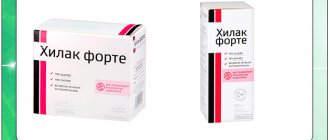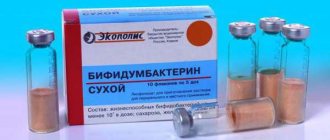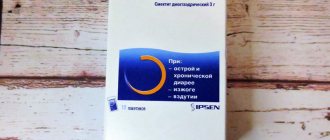Smecta - contraindications
The medicine is a gray-white to yellowish powder with a pleasant vanilla odor. The main active ingredient in it is dioctahedral smectite. It is obtained from a special type of shell rock, which is mined on islands in the Mediterranean Sea. In addition to this, the composition of the drug Smecta contains the following components:
- glucose;
- sodium saccharin;
- vanilla or orange flavoring.
It is not enough to know what Smecta helps with; it is important to understand what indications for use this drug has. The latter are varied. The powder is effective for diarrhea, it is recommended for patients with food and alcohol poisoning, and it also copes very well with the consequences of a hangover and quickly brings you back to your senses.
It is very important to take them into account when starting treatment with Smecta. Otherwise, the medicine will either not be effective, or worse, it will do harm. There are not too many contraindications to the use of the drug. It is not recommended to drink Smecta if you have problems associated with intestinal obstruction. Complete or partial disruption of the movement of contents through the intestines can be caused by disorders of the motor activity of the organ or mechanical obstacles:
- paresis;
- neoplasms in the intestines or neighboring organs;
- hernias;
- foreign bodies;
- gallstones;
- adhesive disease.
People suffering from fructose intolerance or problems with its absorption in the intestines should be treated carefully with Smecta, otherwise using the suspension can lead to constipation. This can happen as a result of weakened intestinal motility. Among other things, allergy sufferers should take Smecta with caution - the drug contains flavorings that can cause an undesirable reaction.
Smecta is not prohibited during pregnancy, but expectant and nursing mothers, of course, need to drink the powder carefully, in consultation with doctors. For pregnant women, the suspension is prescribed for bloating and heartburn, but it must be taken into account that the medication can cause constipation. To prevent negative consequences, it is better to limit therapy to three days.
Smecta is available in sachets containing a ready-made suspension or a white dry mixture for preparing a solution.
| Component name | Definition |
| The active substance is diosmectite. | A combination of aluminum silicate (a mixture of silica, oxygen and aluminum) and magnesium. |
| Dextrose monohydrate | Purified glucose in the form of a white powder. |
| Flavors | Additives used to give the drug a specific odor. |
| Sodium saccharinate | Food additive – sweetener E954 |
Smecta is available in different flavors:
- orange;
- caramel-cocoa (in the form of a ready-made suspension);
- vanilla.
Due to the content of sweetener and flavoring, the prepared solution has a sweet aftertaste and a pleasant aroma. The choice of product depends on individual taste preferences and body reactions; flavorings do not affect the pharmacological effect of the drug.
The drug has no contraindications for use by children over 3 months and pregnant women.
Smecta (instructions for use in sachets for adults include consultation with a doctor before use) is prescribed for various pathologies.
For example:
- acute or chronic diarrhea (due to poisoning or malnutrition);
- vomiting with large loss of fluid;
- heaviness in the stomach;
- heartburn;
- allergies;
- poisoning;
- flatulence;
- treatment of diseases of the intestinal tract (gastritis, enteritis, rotavirus or ulcers).
Smecta is used as part of complex therapy for diseases of the stomach and intestines, providing symptomatic treatment and an adsorbing effect.
Smecta (instructions for use in sachets for adults do not detail the dosage of the drug for each type of intestinal disorder) has a different pattern of use depending on the intensity of the symptoms. For nausea and subsequent vomiting, the daily dosage of the drug is 9 g for adults and 3-5 g for preschoolers.
It is applied as follows:
- Pour the powder from 1 sachet into a clean glass.
- Pour 125 ml (half a glass) of warm water into it.
- Use between meals until the symptoms disappear completely.
In case of severe vomiting, the drug has a positive effect on the organs of the abdominal wall, reducing their tone and thereby inhibiting the vomiting center, which is responsible for the feeling of nausea. It is recommended to alternate Smecta with frequent drinking of plain water or with drugs that restore water-salt balance (for example, Regidron) to prevent dehydration.
Smecta (instructions for use in sachets for adults allows for the treatment of chronic and acute diseases of the abdominal organs with the drug) is widely used in modern therapy of intestinal and gastric disorders.
The drug is part of combination therapy for diseases such as:
- Enteritis.
- Polyposis.
- Cholecystitis.
- Esophagitis.
- Duodenitis.
All diseases are characterized by disruption of the gastrointestinal tract, due to an increase in the content of pathogenic microorganisms that provoke a deterioration in the natural processes of mucus formation and blood circulation. Smecta, thanks to its enveloping and protective functions, facilitates the course of the disease through the timely removal of these same microorganisms.
In complex treatment, the dosage of the drug does not exceed 9 g of the active substance for adults, and 6 g for children over 3 years of age. The course of treatment depends on the severity of the disease and the intensity of the symptoms.
According to the instructions for use by adults, Smecta suspension in sachets contains a minimum number of contraindications.
It is not recommended for use when:
- Intestinal obstruction (blockage of the small or large intestine).
- Fructose intolerance (negatively affects the digestion of glucose, which is part of Smecta).
- Hypersensitivity to the composition of the drug.
There are also a number of nuances that you should know before use:
- Smecta is prescribed with caution for chronic constipation.
- The drug should not be used simultaneously with alcohol.
- The interval between doses of the suspension should be at least 1-2 hours.
In the treatment of chronic gastrointestinal diseases, Smecta is prescribed only as part of complex therapy.
Indications for use:
- Enterocolitis
- Poisoning of various natures
- Pancreatitis
- Stomach ache
- Flatulence
- Diarrhea
- Jaundice in newborns
Contraindications:
- Intestinal obstruction
- Glucose intolerance
- Individual intolerance
Contraindications and side effects
Despite its beneficial properties, Smecta can be harmful if taken without taking into account contraindications. The adsorbent should not be used if the patient has at least one risk factor:
- Individual hypersensitivity
- Intestinal obstruction
- Congenital fructose intolerance, glucose and galactose absorption disorder, isomaltase/sucrase deficiency.
Taking Smecta to eliminate bloating can cause a negative reaction in the body in the form of allergies, and if high dosages are used for too long, it can cause constipation.
In addition, it is necessary to take into account the peculiarities of the interaction of Smecta with other drugs. If the patient is taking any medications, they should be taken separately - with an interval of at least 1-2 hours. Otherwise, their therapeutic effect will be reduced, since the adsorbent will bind and remove the active substances from the body.
This article was written by specialists with medical education from the team. You can read the original instructions on the manufacturer’s website: Smecta.
Smecta in bags: instructions for use for children and adults
In case of intoxication (poisoning) of the body, special complex therapy is used, aimed at immediately improving the condition. For these purposes, sorbents are used, which include Smecta. They have a cleansing effect on the body, removing toxic substances that provoke the appearance of acute symptoms of poisoning.
Smecta in this case is prescribed before other drugs, the maximum daily dosage is:
- 9 sachets for adults;
- 4 sachets for children of school and preschool age;
- 2 sachets for babies under 2 years old.
The powder is diluted in water and drunk throughout the day in equal portions. For the first 2 days, the dose is maximum; on the 3rd and subsequent days, the number of sachets taken per day should be halved.
Heartburn occurs due to irritation of the gastric mucosa by a high concentration of hydrochloric acid. The use of Smecta helps to cope with excess of this acid, quickly removing it naturally and protecting the intestinal walls through the formation of high-quality mucus.
The daily dosage of the drug in this case is standard:
- 3 sachets for adults.
- 2 sachets for children from 3-5 years old.
- 1 sachet for children under 2 years old.
For chronic heartburn, it is important to remember that Smecta treats the consequences and symptoms, and not the cause of the pathology itself. For effective therapy, the diet and intestinal microflora should be adjusted.
You can take the medicine from birth. Often the medicine is prescribed for jaundice in newborns.
Instructions:
- Children under one year old. Dissolve 1 packet of the substance in 100 ml of boiled water and give throughout the day. That is, the baby should drink the suspension not at once, but over the course of a day. Try to divide into equal portions.
- Children from 1 to 2 years old. No more than 2 sachets per day. In the same way, the drug is dissolved in 200 ml of water (2 sachets) and given to the baby throughout the day.
The drug is used in different quantities for adults and children.
Dosage:
- Adults. 4-6 sachets per day
- 1-2 sachets for children under 5 years old per day
The regimen is quite simple:
- Children under one year old - 1 sachet per 100 ml of water per day
- Children under 2 years old – 2 sachets of 200 ml and drink per day
- Adults - 1 sachet per 100 ml of water 4-6 times a day
If you are pregnant and suffer from heartburn due to the high position of the uterus, take enterosorbents. In this case, it is necessary to take the drug immediately after eating. The daily norm is 4 sachets.
How does Smecta work?
The first results can be seen after 2-3 hours. This is exactly how long it takes for the sorbent to absorb toxins and pathogenic microorganisms.
The main active ingredient of the drug, diosmectite, is used as a sorbent that helps remove harmful toxins and pathogenic microorganisms from the body.
Smecta acts as follows: penetrating the intestinal mucosa, the drug stabilizes its protective function by increasing the amount of mucus. Mucus has a positive effect on the removal of excess bile salts, hydrochloric acid and harmful microorganisms from the intestine, normalizing its microflora.
Smecta also has:
- Antidiarrheal properties.
- Antiemetic effect.
- Restoring properties against lost fluid.
- Increases blood circulation.
- Enveloping properties.
Due to its glucose content, Smecta increases diuresis, thereby accelerating the elimination of pathogenic substances from the body.
Smecta has a quick effect on the intestines. Due to its liquid consistency, the substances penetrate inside and begin to perform their functions within 10 minutes after taking the drug. The effect of one dose lasts about 3-4 hours.
Knowing what effect the drug has will help you understand what Smecta helps with. Very often, if proper nutrition is not followed, viral infections, poisoning, or imbalance of intestinal microflora, unpleasant sensations appear in the stomach. Smecta has increased adsorption activity and quickly relieves unwanted symptoms.
Remembering how Smecta acts on the body, it is important to note that the medication performs two important functions:
- Adsorption and removal of toxins. Smecta's cellular structure allows it to bind and remove various harmful agents.
- Protection. Removing hazardous substances is not the only function of the drug. Among other things, it can protect the intestinal walls. Smecta envelops the site of injury and continues to be present on the mucous membrane for up to 6 hours after administration, promoting its recovery.
Is Smecta effective for vomiting? Yes, but only if the toxin entered the body through the stomach. The main task of the drug is the adsorption of poisons, toxins, bacteria and waste products of the latter. Due to the enveloping effect, irritation of the intestinal mucosa is reduced.
Smecta for diarrhea
What else does Smecta help with - diarrhea. The origin of diarrhea does not matter - the drug copes equally effectively with disorders caused by both low-quality products and pathogenic microorganisms or allergens. Smecta works against diarrhea in the same way as against poisoning - the medication adsorbs dangerous substances and quickly removes them from the body, resulting in relief.
Smecta for heartburn
Remembering what Smecta helps with, we must not forget such a problem as heartburn. The main effect of the drug in this case is aimed at restoring the mucous barrier of the intestines and stomach. Simply put, the medication forms a special protective film. An increase in the amount of mucus reduces the negative effect of hydrochloric acid on the stomach walls, and Smecta against heartburn helps.
The medicine can be used during pregnancy. It will not cope with the causes of unpleasant sensations, but it can effectively reduce the burning sensation. Smecta will take on a certain amount of hydrochloric acid and protect the gastric mucosa in areas of defects. Thanks to this, the attack will become less painful, the condition of the expectant mother will improve, and no harm will be done to the fetus.
For many patients, it is not enough to know what Smecta helps with. It is also important for them to understand how quickly the drug works and when relief can be expected. Good news: the compound of magnesium and aluminum in the gastric walls promotes the rapid dissolution of the substance, and improvement occurs almost immediately after administration.
Indications
Smecta is an antidiarrheal medicine (for the treatment of diarrhea). The active ingredient of this drug is able to improve and stabilize the mucous barrier of the stomach and intestinal tract by increasing the amount of mucus, while the intestinal mucosa becomes denser, its ability to resist harmful and irritating substances increases, and signs of poisoning quickly subside.
The drug also reduces the negative effects of toxins (poisonous substances) and pathogens. The drug, entering the intestines, binds the toxic compounds present in it and removes them with human feces. Thanks to this specific pharmacological effect, Smecta acts only on those bacteria, viruses and toxins that are located in the lumen of the digestive tube. The active substance of the taken suspension is not absorbed by the body and does not enter the bloodstream, but leaves the intestines along with harmful microbes and chemicals. Taking Smecta in prescribed doses does not cause disturbances in intestinal motility (motility).
Dioctahedral smectite does not stain feces and is radiolucent; the aluminum in its composition is not absorbed in the intestine even if its wall is damaged (progressive colitis, colonopathy, other diseases of the stomach and intestines).
The main feature of this drug is that it is safe for the body and can be used in children from a very early age (almost from birth).
Main indications for use of Smecta:
- chronic, drug-induced, allergic diarrhea (frequent and loose stools);
-food poisoning;
-diarrhea caused by eating low-quality foods or poor nutrition;
- diseases of the gastrointestinal tract, which are characterized by diarrhea (cholecystitis, peptic ulcer, gastritis, colitis and others) - in this case, the drug helps get rid of flatulence (bloating), discomfort in the intestinal area, heartburn;
-diarrhea resulting from long-term treatment with antibacterial drugs (due to dysbacteriosis, proliferation of opportunistic bacteria);
-acute infectious intestinal diseases - eschechiriosis, clostridiosis, cholera, salmonellosis, campylobacteriosis, stomach flu (norovirus).
Smecta acts not only as an enterosorbent (a substance that binds toxins in the stomach and intestines), but also has a therapeutic effect in case of deficiency of magnesium, sodium and potassium in the body (which is often a complication of diarrhea), stabilizing the balance of water and minerals.
Smecta - side effects
Even 100% natural drugs can lead to side effects. It all depends on the characteristics of the body. Smecta does not cause side effects very often, but nevertheless they sometimes occur. Clinical studies report rare cases of constipation. True, almost always the phenomena were mild and went away immediately after adjusting the dosage. The reason for this side effect is that Smecta slightly reduces intestinal motility.
Other possible adverse reactions include hives, itching, and rashes. In extremely rare cases, doctors have had to deal with Quincke's edema. Be that as it may, if undesirable symptoms appear during treatment with Smecta, it is recommended to consult a specialist and either adjust the treatment regimen or select an alternative medicine.
Smecta is a natural sorbent of organic origin. The active ingredient of the drug is diosmectite. This sorbent is not absorbed in the intestines and is excreted unchanged from the body. The mechanism of action of the drug is based on high absorption capacity. Thanks to this, toxins, viruses and bacteria are absorbed inside the intestines. Accordingly, the drug detoxifies the body, which helps stop diarrhea and vomiting.
In medical practice, the following side effects were observed when taking Smecta:
- the appearance of constipation (when using the drug in case of chronic constipation or intestinal obstruction);
- the appearance of allergic reactions (rash, redness of the skin, swelling);
- decreased effectiveness of other drugs when taken simultaneously.
According to practical studies, such effects occur extremely rarely, mainly with independent and uncontrolled use of the drug.
Contraindications
Any drug can negatively affect the patient’s condition if he has problems with the functioning of certain organs and systems. In order not to worsen your health, you should find out for whom the medicine is contraindicated. Smecta has the following contraindications:
- Intestinal obstruction of any origin.
- Fructosemia.
- Glucose-galactose malabsorption syndrome.
- Malabsorption of sucrose-isomaltose.
- Hypersensitivity to active and additive components in the composition.
Analogs
Smecta is a sorbent of organic origin.
Analogues of Smecta:
- Enterosgel
- Activated carbon
- Polysorb
- Phosphalugel
Smecta is part of the pharmacological group of sorbents and antidiarrheals, which are characterized by a large list of drugs with similar effects.
The most popular analogues of Smecta sorbents are:
- Enterosgel. It has a beneficial effect on the treatment of poisonings and intoxications of a domestic or infectious nature. Used by pregnant women and children from 3 months. Contraindicated in intestinal atony (impaired tone of the intestinal wall and weakened peristalsis). Requires continued use after symptoms disappear. The cost of the drug ranges from 380 to 550 rubles.
- Polyphepan. This is a drug presented in the form of a powdery substance. Stimulates gastrointestinal peristalsis and improves metabolic processes of lipids (building cells). Unlike Smecta, it produces a weak absorption effect, since it is aimed mainly at providing a regenerating and detoxifying effect. It is also used for the treatment of gynecological diseases (cystitis, colpitis, vaginosis and others). The drug, despite its effective effect on the gastrointestinal tract, has contraindications such as internal bleeding, anacid gastritis and ulcerative lesions of the mucous membrane. This is a relatively cheap product with an average cost of 50 rubles.
- Polysorb. Widely used for detoxification of the body due to intestinal infections. Has a sorbent and antioxidant effect. It has different treatment regimens for each indication for use. With long-term use of 2 weeks or more, the absorption of vitamins and other nutrients may be impaired. The drug can be used externally to stop bleeding and in the treatment of purulent wounds. The price ranges from 60 to 500 rubles, depending on the form of release and the pricing policy of pharmacies.
- Multisorb. It has a complex effect that has a positive effect on energy metabolism and intestinal microflora. This product absorbs pathogenic microorganisms and reduces the risk of developing arterial diseases. The list of indications is very large, it includes the treatment of intoxication, atherosclerosis, diabetes mellitus, intestinal infections and purulent-inflammatory pathologies. The drug is contraindicated in pancreatitis, calculous cholecystitis and internal intestinal bleeding. The average cost of Multisorb is 300 rubles.
The following drugs can be considered analogues of Smecta in terms of antidiarrheal effect:
- Diosmectite. The name of the drug fully corresponds to the name of the active substance. It is a Russian analogue of Smecta and has similar sorbing pharmacological properties and a mechanism of action aimed at improving the condition of diarrhea and intoxication. The price of the drug is on average 100 rubles.
- Activated carbon. An adsorbent that has an antidiarrheal effect. The drug is available in the form of black tablets. Indications for use are completely the same as Smecta, the only difference is in the number of contraindications, which include: ulcerative lesions of the gastrointestinal tract, internal bleeding, duodenal disorders. It is worth paying attention that the development of hypovitaminosis is possible. When using the drug, the feces turn black. The cost of activated carbon varies from 2 to 124 rubles.
- Diara. The product is available in tablet form and has a pronounced antidiarrheal effect. Diara slows down intestinal motility and increases the time it takes for feces to pass through the colon. The action comes quickly. However, the drug cannot be used during pregnancy, children under 6 years of age, during lactation and in the presence of intestinal obstruction.
Smecta is an effective drug that helps eliminate the symptoms of gastrointestinal disorders. The product has simple instructions for use and a convenient release form in the form of bags with a ready-made suspension or granules for dissolution.
The variety of pleasant tastes of the drug makes it easier for both adults and children to take the drug. To avoid complications of the disease and adverse reactions, it is recommended to consult a doctor before taking Smecta.
Author of the article: Natalya G.
Article design: Oleg Lozinsky
You can buy Smecta at any pharmacy without presenting a prescription. This is a harmless drug that helps almost everyone, almost always, but there are exceptions. For some patients, the suspension is not suitable for one reason or another, and they have to look for alternative drugs. The most popular Smecta analogue is Neosmectin.
- Diosmectin;
- Doisorb;
- Benta;
- Apsorbin Sachet;
- Smectite;
- Atoxyl;
- Maxisorb;
- Polypephane;
- Poisorb;
- Filtrum;
- Ultrasorb;
- Enterosgel;
- Sorbentogel.
Analogues of the drug
If Smecta is not suitable, or it is not in your home medicine cabinet, then you can use other similar drugs of natural origin:
- activated carbon is a sorbent of past generations, but its popularity and effectiveness are still high;
- White carbon is a modern analogue of activated carbon, but has an extended spectrum of action. Before use, carefully read the contraindications, they are broader than those of Smecta;
- Polysorb – contains silicon dioxide and has an extended spectrum of action;
- Enterosgel - sold in gel form, similar in action to Smecta;
- Ultra-Adsorb or Sorbex - black capsules containing activated carbon and some other components;
- Neosorb is a modern drug for the treatment of diarrhea based on sorbitol.
Among the complete analogues of Smecta, Neosmectin and Diosmectin are distinguished. The substances are also available in powder form.
When to take Smecta - before or after meals
In general, the dosage of the drug is the same, but the number of sachets per day varies depending on the type of disorder and illness. On average, you need to drink 4-6 sachets of the drug per day. You should not drink the solution immediately after eating. In general, the adsorbent is taken an hour before meals or an hour after it. Ideally, on an empty stomach.
Smecta can be taken not only when a hangover occurs, but also to prevent it. That is, before the feast. If the party is scheduled for the evening, then throughout the day you need to take 2-3 sachets of Smecta. To avoid pronounced symptoms in the morning, you need to drink Smecta again after the feast before going to bed.
At the same time, the process of active elimination of ethyl alcohol will begin in the body. But it is better to first induce a gag reflex and only then drink 2 sachets of medicine together. If another 1.5 hours have not passed after taking the drug, and the gag reflex appears again, then you need to take Smecta again.
The regimen for using Smecta depends on the cause of gastrointestinal symptoms:
- For heartburn, the solution is recommended to be consumed immediately after meals.
- For acute diarrhea, poisoning, allergies and abdominal diseases, Smecta is taken between meals.
- As a preventive measure, the drug is taken with meals.
Indications for use
The use of Smecta for diarrhea is indicated in the following cases:
- poisoning by toxins;
- disruption of the gastrointestinal tract caused by poor nutrition;
- irritable bowel syndrome;
- chronic gastrointestinal pathologies;
- digestive disorders while taking antibiotics;
- intestinal infections;
- elimination of clinical manifestations of gastritis, cholecystitis and ulcers;
- flatulence and heartburn;
- toxicosis;
- jaundice in newborns;
- allergy.
Overdose of Smecta
With physiological jaundice, enterosorbents are indicated for the removal of toxins. One sachet per day is enough. Dissolve in 100 ml of water and give throughout the day.
If the drug is abused, the following undesirable consequences may occur:
- the occurrence of fecal obstruction in the colon and rectum;
- the appearance of such a gastric disorder as a bezoar (stomach stone);
- dysfunction of the intestinal mucosa.
Therefore, before use, it is necessary to discuss in detail with your doctor the dosage and treatment regimen individually.
How to take Smecta for stomach and abdominal pain, flatulence, bloating?
For stomach pain and bloating, take 4 sachets per day, diluting each with 100 ml of water.
Gastritis provokes excessive formation of hydrochloric acid, which destroys the intestinal mucosa and its microflora. In this case, Smecta is used, which is aimed at protecting the mucous membrane from excessive exposure to acids, enveloping them and gently removing them from the intestines naturally.
For peptic ulcers, the drug has an enveloping effect, increases the viscosity of bile mucus, which promotes the rapid elimination of toxins and excess bile acids that negatively affect the functioning of the large and small intestines.
For children, the dosage should be reduced to 1-2 sachets per day. It is not recommended to delay taking the drug after its preparation, since when in contact with food in the air, there is a high risk of oxidation of the active substance, which leads to a decrease in its therapeutic effect.
Composition and release form
Smecta is an antidiarrheal sorbent, an aluminosilicate of natural origin (porous clay), which has a pronounced adsorbing effect.
The drug is produced in the form of a powder from which a suspension is prepared. It can have an orange or vanilla flavor, which is why children really like this drug. The color of the medicine can be white-gray or yellow-gray. Flavoring substances do not cause allergies.
The powder is packaged in sachets of 3.76 g, of which 3 g is dioctahedral smectite, the main active ingredient. The remaining 0.76 g in each sachet comes from flavorings (vanilla or orange) and other auxiliary components:
- sodium saccharinate;
- dextrose monohydrate.
Each package of the drug may contain 10 or 30 sachets of powder.
How to take Smecta while taking antibiotics?
Allergies provoke a disruption of the natural environment of the intestines, causing the growth of pathogenic microorganisms and reducing the overall immunity of the body. If allergic reactions occur, doctors recommend taking antihistamines and sorbents, which help immune cells fight the foreign protein (allergen) and remove it from the body as effectively as possible.
Most often, allergies manifest themselves in young children, whose intestinal microflora is at the stage of formation and cannot fully perform protective functions. Smecta prevents the absorption of the allergen into the blood, thereby reducing the intensity of allergic reactions.
If appropriate symptoms occur, Smecta should be taken immediately before an antihistamine, a daily dose of 3 sachets for adults, and 1 sachet for children. It is recommended to discuss the dose for children with a doctor in order to avoid overdose and allergic reactions that are possible due to hypersensitivity to the components of the drug.
It depends on how antibiotics are administered. If injected, then Smecta can be given before meals. If antibiotics are in tablets, then you need to drink the antibiotic after meals, and take Smecta no later than an hour before meals.











